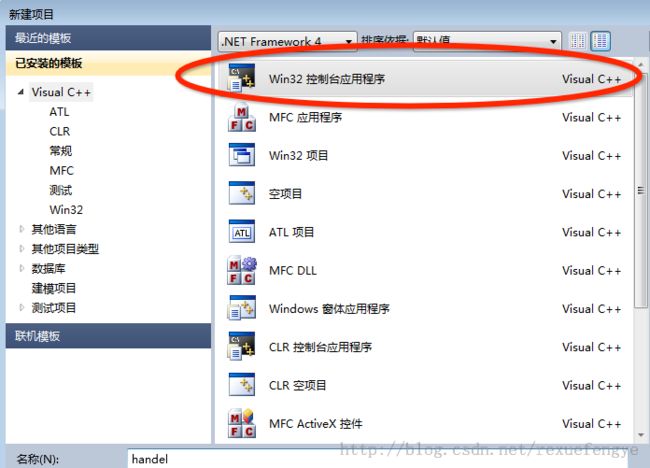C++中句柄
一、句柄的概念
1.windows方面理解:
- 句柄,是整个windows编程的基础。
- 一个句柄是指使用的一个唯一的整数值,即一个四字节长的数值,来标志应用程序中的不同对象和同类对象中的不同的实例,诸如,一个窗口,按钮,图标,滚动条,输出设备,控件或者文件等。
- 应用程序能够通过句柄访问相应的对象的信息,但是句柄不是一个指针,程序不能利用句柄来直接阅读文件中的信息。如果句柄不用在I/O文件中,它是毫无用处的。
- 句柄是windows用来标志应用程序中建立的或是使用的唯一整数,windows使用了大量的句柄来标志很多对象。
2.本人理解:
- C++句柄是一种指向指针的指针。
- C++句柄类的主要目的是在对象层面上实现多态。
二、实例详细说明
1.在visual studio 2010 创建控件器平台:
2.添加两个类,helloA,helloB
helloA.h
#pragma once
class helloA
{
public:
helloA(void);
~helloA(void);
virtual void func()const{printf("A");}
}; helloB.h
#pragma once
#include "helloa.h"
class helloB :
public helloA
{
public:
helloB(void);
~helloB(void);
void func()const{printf("B");}
}; handel.cpp
#include "stdafx.h"
#include "helloA.h"
#include "helloB.h"
#include <vector>
using namespace std;
int _tmain(int argc, _TCHAR* argv[])
{
vector<helloA> vec;
helloA a;
helloB b;
vec.push_back(a);
vec.push_back(b);
for ( vector<helloA>::iterator iter=vec.begin();iter!=vec.end();iter++)
{
(*iter).func();
}
return 0;
}
运行的结果:
原因:vec.push_back(b); ,其实把截断了,将b转化为了它的基类helloA.
如何解决这个问题,可以用指针代替对象方法:如:vector<helloA*>vec;这样做可以达到多态的目的,但程序员必须接管内存管理,例如,更改下handel.cpp代码:
vector<helloA*> vec;
helloA *a = new helloA;
helloB *b = new helloB;
vec.push_back(a);
vec.push_back(b);
for ( vector<helloA*>::iterator iter=vec.begin();iter!=vec.end();iter++)
{
(*iter)->func();
}
运行结果:
效果达到,但问题来了,这里假如vec的生命周期结束了,vec不会主动释放b所占用的内存,如果不手动delete b,就会产生内存泄漏。
接下来,就实现下句柄类,来解决如上问题。
更改下helloA,helloB的代码:
helloA.h
#pragma once
class helloA
{
public:
helloA(void);
~helloA(void);
virtual void func()const{printf("A");}
virtual helloA* clone() const {return new helloA(*this);}
}; helloB.h
#pragma once
#include "helloa.h"
class helloB :
public helloA
{
public:
helloB(void);
~helloB(void);
void func()const{printf("B");}
virtual helloB* clone() const{return new helloB(*this);}
};
同时,添加sample类,记得把sample.cpp的代码注释掉,我们只在sample头文件更改代码即可。
sample.h
#pragma once
#include "helloA.h"
#include "helloB.h"
#include <stddef.h>
class sample
{
public:
sample():p(0),use(1){};
sample(const helloA& a):p(a.clone()),use(1){};
sample(const sample&i):p(i.p),use(i.use){use++;}
~sample(){decr_use();};
sample& operator = (const sample& i)
{
use++;
decr_use();
p = i.p;
use = i.use;
return *this;
}
const helloA *operator->() const {if (p)return p;}
const helloA &operator*() const{if(p)return *p;}
private:
helloA* p;
size_t use;
void decr_use(){if (-use == 0)delete p;}
};
回到main函数,更改代码
handle.cpp
// handle.cpp : 定义控制台应用程序的入口点。
//
#include "stdafx.h"
#include "helloA.h"
#include "helloB.h"
#include "sample.h"
#include <vector>
#include <list>
using namespace std;
int _tmain(int argc, _TCHAR* argv[])
{
vector<sample> vec;
helloA a;
helloB b;
sample sample1(a);
sample sample2(b);
vec.push_back(sample1);
vec.push_back(sample2);
for ( vector<sample>::iterator iter=vec.begin();iter!=vec.end();iter++)
{
(*iter)->func();
}
return 0;
}
运行结果:
我们得到了正确的输出,如同shared_ptr,我们引入了计数,在vec生命周期结束时,我们不需要自己释放内存。
对上面代码需要注意,为什么克隆函数,要用virtual helloA* clone() const {return new A(*this);}而不是直接virtual A*clone() const {return this;}
因为,这样潜在一个问题,比如
helloB b;
sample sam(b);
vec.push_back(sam);
当b的生命周期结束,而vec的生命周期尚未结束时,调用(*iter)->A.func();就会出错,而更直接的是,这样做与直接用指针进行多态没有太大区别了。
参考文章:http://blog.csdn.net/linuxtiger/article/details/6879366/

